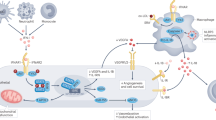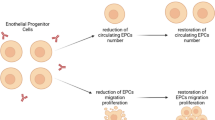Abstract
In flares of systemic lupus erythematosus (SLE), endothelial cells activated by immune stimuli are potential participants in the inflammatory processes, which contribute to injury. Elevated levels of circulating endothelial cells (CEC) may be a proxy for vascular injury, as demonstrated in patients with sickle cell anemia during acute crises. In active SLE, CEC levels in peripheral blood are elevated (vs healthy controls and correlate with plasma C3a). CEC may reflect widespread unrecognized, ongoing injury despite the absence of clinical stigmata of vasculitis in patients with SLE.
Similar content being viewed by others
References and Recommended Reading
Argenbright LW, Barton RW: Interactions of leukocyte integrins with intercellular adhesion molecule 1 in the production of inflammatory vascular injury in vivo. The Shwartzman reaction revisited. J Clin Invest 1992, 89:259–272.
Saadi S, Holzknecht RA, Patte CP, et al.: Complementmediated regulation of tissue factor activity in endothelium. J Exp Med 1995, 182:1807–1814.
Lozada C, Levin RI, Huie M, et al.: Identification of C1q as the heat-labile serum cofactor required for immune complexes to stimulate endothelial expression of the adhesion molecules E-selectin and intercellular and vascular cell adhesion molecules 1. Proc Natl Acad Sci U S A 1995, 92:8378–8382. A seminal finding, which in part explains the development of immune-complex-mediated vasculitis. Immune complexes fix C1q, and the complex interacts with the C1q receptor to stimulate endothelial expression of adhesion molecules.
Belmont HM, Buyon J, Giorno R, et al.: Up-regulation of endothelial cell adhesion molecules characterizes disease activity in systemic lupus erythematosus. The Shwartzman phenomenon revisited. Arthritis Rheum 1994, 37:376–383. This paper describes a relationship between the occurrence of endothelial cell activation in otherwise "healthy" patient tissue and disease activity, providing vidence that vascular tissue is primed for tissue injury.
Cronstein BN, Kimmel SC, Levin RI, et al.: A mechanism for the antiinflammatory effects of corticosteroids: the glucocorticoid receptor regulates leukocyte adhesion to endothelial cells and expression of endothelial-leukocyte adhesion molecule 1 and intercellular adhesion molecule 1. Proc Natl Acad Sci U S A 1992, 89:9991–9995. This article provides an explanation for the efficacy of corticosteroids in the treatment of acute flares of SLE. Corticosteroids prevent the activation-dependent expression of adhesion molecules in cultured endothelial cells.
Clancy RM, Abramson SB: Nitric oxide: a novel mediator of inflammation. Proc Soc Exp Biol Med 1995, 210:93–101.
Belmont HM, Levartovsky D, Goel A, et al.: Increased nitric oxide production accompanied by the up-regulation of inducible nitric oxide synthase in vascular endothelium from patients with systemic lupus erythematosus. Arthritis Rheum 1997, 40:1810–1816.
Weinberg JB, Granger DL, Pisetsky DS, et al.: The role of nitric oxide in the pathogenesis of spontaneous murine autoimmune disease: increased nitric oxide production and nitric oxide synthase expression in MRL-lpr/lpr mice, and reduction of spontaneous glomerulonephritis and arthritis by orally administered NG-monomethyl-L-arginine. J Exp Med 1994, 179:651–660. Excessive nitric oxide production is liked to the MRL/lpr model of SLE.
Gilkeson GS, Mudgett JS, Seldin MF, et al.: Clinical and serologic manifestations of autoimmune disease in MRL-lpr/lpr mice lacking nitric oxide synthase type 2. J Exp Med 1997, 186:365–373.
Clancy RM, Rediske J, Tang X, et al.: Outside-in signaling in the chondrocyte. Nitric oxide disrupts fibronectin-induced assembly of a subplasmalemmal actin/rho A/focal adhesion kinase signaling complex. J Clin Invest 1997, 100:1789–1796.
Solovey A, Lin Y, Browne P, et al.: Circulating activated endothelial cells in sickle cell anemia [see comments]. N Engl J Med 1997, 337:1584–1590.
Solovey A, Gui L, Key NS, et al.: Tissue factor expression by endothelial cells in sickle cell anemia. J Clin Invest 1998, 101:1899–1904.
Buyon JP, Tamerius J, Belmont HM, et al.: Assessment of disease activity and impending flare in patients with systemic lupus erythematosus. Comparison of the use of complement split products and conventional measurements of complement. Arthritis Rheum 1992, 35:1028–1037. Activated complement is present in circulation of patients with disease.
George F, Poncelet P, Laurent JC, et al.: Cytofluorometric detection of human endothelial cells in whole blood using S-Endo 1 monoclonal antibody. J Immunol Methods 1991, 139:5–75.
Lefevre P, George F, Durand JM, et al.: Detection of circulating endothelial cells in thrombotic thrombocytopenic purpura [letter]. Thromb Haemost 1993, 69:522.
Solovey A, Gui L, Ramakrishnan S, et al.: Sickle cell anemia as a possible state of enhanced anti-apoptotic tone: survival effect of vascular endothelial growth factor on circulating and unanchored endothelial cells. Blood 1999, 93:3824–3830.
Mutin M, Canavy I, Blann A, et al.: Direct evidence of endothelial injury in acute myocardial infarction and unstable angina by demonstration of circulating endothelial cells. Blood 1999, 93:2951–2958.
Moder KG, Miller TD, Tazelaar HD: Cardiac involvement in systemic lupus erythematosus. Mayo Clin Proc 1999, 74:275–284.
Gladman DD, Urowitz MB: Morbidity in systemic lupus erythematosus. J Rheumatol 1987, 14 Suppl 13:223–226.
Rosner S, Ginzler EM, Diamond HS, et al.: A multicenter study of outcome in systemic lupus erythematosus. II. Causes of death. Arthritis Rheum 1982, 25:612–617.
Egawhary DN, Swoboda BE, Chen J, et al.: Damage to the vascular endothelium of diabetic patients can be assessed by analyzing blood samples for the number of circulating endothelial cells with mitochondrial DNA deletions. Biochem Soc Trans 1995, 23:402S.
Grefte A, van der Giessen M, van Son W, et al.: Circulating cytomegalovirus (CMV)-infected endothelial cells in patients with an active CMV infection. J Infect Dis 1993, 167:270–277.
Drancourt M, George F, Brouqui P, et al.: Diagnosis of Mediterranean spotted fever by indirect immunofluorescence of Rickettsia conorii in circulating endothelial cells isolated with monoclonal antibody-coated immunomagnetic beads. J Infect Dis 1992, 166:660–663.
Laurence J, Mitra D: Apoptosis of microvascular endothelial cells in the pathophysiology of thrombotic thrombocytopenic purpura/sporadic hemolytic uremic syndrome. Semin Hematol 1997, 34:98–105.
Frenkel SR, Clancy RM, Ricci JL, et al.: Effects of nitric oxide on chondrocyte migration, adhesion, and cytoskeletal assembly. Arthritis Rheum 1996, 39:1905–1912.
Author information
Authors and Affiliations
Rights and permissions
About this article
Cite this article
Clancy, R.M. Circulating endothelial cells and vascular injury in systemic lupus erythematosus. Curr Rheumatol Rep 2, 39–43 (2000). https://doi.org/10.1007/s11926-996-0067-6
Issue Date:
DOI: https://doi.org/10.1007/s11926-996-0067-6




